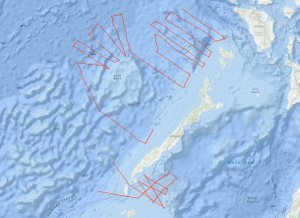In the southwestern part of the Sulu Sea and in the southeastern part of the South China Sea, between NW Palawan and the northwestern part of the Reed Bank the Federal Institute for Geosciences and Natural Resources (BGR), Hannover carried out the geophysical survey BGR84 from 11th October, 1984 to 23rd November, 1984. This work was done in close cooperation with the Bureau of Mines and Geosciences (BMG), Manila, using the German seismic vessel EXPLORA chartered from PRAKLA-SEISMOS GmbH, Hannover. Multichannel reflection seismic measurements were carried out on 40 lines with a total length of 4,467 km simultaneously with magnetic measurements on 19 lines with a total length of 3,047 km. The Oligocene to lower Miocene Nido-carbonates of the South China Sea that have been proven during the SONNE cruises SO-23 and SO-27 beneath the allochthonous and chaotically deformed complex which was overthrusted from the Sulu Sea terrane, could be correlated up to the Balabac Straits. The three major unconformities of the Sulu Sea, unconformity A (Early Pliocene), unconformity B (mid Middle Miocene) and unconformity C (lower Middle Miocene) have been correlated over extensive areas by tying into the Sulu Sea well Coral-1. In the Sulu Sea reflection horizon C forms the top of a chaotic bedded rock complex and presumably represents an equivalent to the unconformity "Red" of the South China Sea, in the west of Palawan. There, the unconformity "Red" forms the surface of a highly deformed rock complex which has been interpreted as an allochthonous mass accumulation (HINZ, 1983; HINZ & SCHLÜTER, 1985). It is assumed that pronounced magnetic anomalies, approximately 140 - 160 km off NW Palawan as well as a change in the reflection seismic pattern of the acoustic basement, associated with diapiric structures which are interpreted as intrusions represent the ocean-continent boundary in this part of the South China Sea. In the Reed Bank area the basement type which is interpreted as continental crust (transitional crust?) extends as far as 160 km to the northwest, towards the South China Sea Basin. The northern part of the Reed Bank is characterized by intense downfaulting and rotated fault blocks with reef complexes ontop. In contrast to results from the Dangerous Grounds of the previous SONNE cruises, the deeper lying coherent reflections could be recognized in the monitor records off the northwestern Reed Bank area. It might be that these parts of the Reed Bank block consists of metamorphized and/or highly consolidated rocks of pre-Tertiary age which originally formed part of the Chinese back country, and which was effected by previous orogenies prior to the rifting of the proto-China continental margin. Auf der EXPLORA-Fahrt BGR84 sind in der Zeit vom 11. Oktober bis zum 23. November 1984 im südwestlichen Teil der Sulu See und im südöstlichen Teil des Südchinesischen Meeres, zwischen NW Palawan und der nordwestlichen Reed Bank, 40 Profile mit einer Gesamtlänge von 4.467 km mit digitaler Reflexionsseismik und 19 Profilen von insgesamt 3.047 km Länge mit Magnetik vermessen worden. Die während der SONNE-Fahrten SO-23 und SO-27 nachgewiesene oligozäne-untermiozäne Karbonatplattform des Südchinesischen Meeres mit Riffstrukturen vom Nido-Typ ist unter dem von Südosten aufgeschobenen, allochthonen Komplex aus chaotisch gelagerten Gesteinen der Sulu-See bis unter die Balabac-Straße zu verfolgen. Durch Überfahren der Sulu-See-Bohrung Coral-1 ist es möglich, die drei Hauptunkonformitäten A (frühes Pliozän), B (mittleres Mittelmiozän) und C (frühes Mittelmiozän) in den seismischen Registrierungen aus der Sulu-See über große Strecken zu korrelieren. Reflexionshorizont C der Bohrung Coral-1 bildet in der Sulu-See die Oberkante einer chaotisch gelagerten Gesteinsfolge und könnte das Äquivalent der Unkonformität "Rot" im Südchinesischen Meer, westlich von Palawan, sein. Die Unkonformität "Rot" bildet dort den Top eines ebenfalls stark deformierten Gesteinskomplexes mit chaotischen Lagerungsverhältnissen, der als allochthone Gesteinsakkumulation gedeutet wird (HINZ, 1983; HINZ & SCHLÜTER, 1985). Markante Änderungen im Reflexionsmuster des akustischen Basements, assoziiert mit diapirähnlichen und als Intrusionen gedeutete Strukturen sowie starke magnetische Anomalien im Südchinesischen Meer, etwa 140 - 180 km vor NW Palawan markieren vermutlich die Grenze zwischen kontinentaler und ozeanischer Kruste. Im Gebiet der Reed Bank setzt sich der als kontinentale Kruste (Übergangskruste?) gedeutete Basementtyp um etwa weitere 150 km nach Nordwesten in das Südchinesische Tiefseebecken fort. Der Nord- und Nordwestteil der Reed Bank ist durch intensive Blocktektonik mit seewärts gekippten Einzelschollen gekennzeichnet, die von Riffen überwachsen sind. Im Unterschied zu den Resultaten der SONNE-Fahrten von den Dangerous Grounds fehlen im Gebiet der norwestlichen Reed Bank tiefere, korrelierbare Reflexionshorizonte fast vollständig. Da diese Gebiete vor der Trennung vom proto-chinesischen Kontinentalrand durch Rifting Bestandteil des chinesischen Hinterlandes bildeten, könnte der Sockel der nördlichen Reed Bank aus metamorphen resp. aus hochkonsolidierten prätertiären Gesteinen bestehen, die keine markanten Impedanzunterschiede aufweisen.





